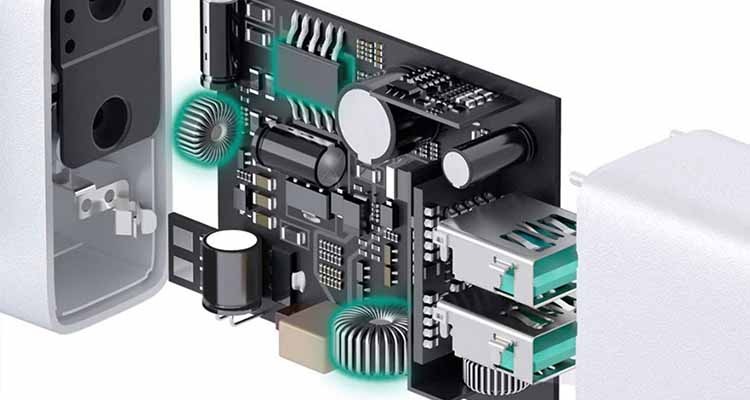The emerging market for silicon carbide (SiC) and gallium nitride (GaN) power semiconductors is forecast to pass the $1 billion mark in five years. But in the last two years things have changed drastically for both materials: SiC has made its entry in Tesla’s cars in 2018, while GaN found its way in the Oppo, Samsung, Xiaomi, Realme’s fast chargers in Q4/2019 and Q1/2020. While SiC continues its flight, GaN has only started its bright journey and is evolving very rapidly.
The emerging market for silicon carbide (SiC) and gallium nitride (GaN) power semiconductors is forecast to pass the $1 billion mark in five years, energized by demand from hybrid and electric vehicles, power supplies and photovoltaic (PV) inverters. Worldwide revenue from sales of SiC and GaN power semiconductors is projected to rise to $3.7 billion in 2025, up from just $210 million in 2015, according to IHS Inc., the global source of critical information and insight. Market revenue is also expected to rise with double digit growth annually for the next decade.
SiC Schottky diodes have been on the market for more than 10 years, with SiC metal-oxide semiconductor field-effect transistors (MOSFET), junction-gate field-effect transistors (JFET) and bipolar junction transistors (BJT) appearing in recent years, according to the latest information from the latest IHS SiC & GaN Power Semiconductors Report. SiC MOSFETs are proving very popular among manufacturers, with several companies are already offering them, and more are expected to in the coming year. The introduction of 900 volt (V) SiC MOSFETs, priced to compete with silicon SuperJunction MOSFETs, as well as increased competition among suppliers, forced average prices to fall in 2015.
“Declining prices will spur faster adoption of the technology,” said Richard Eden, senior market analyst for power semiconductor discretes and modules at IHS Technology. “In contrast, GaN power transistors and GaN modules have only just recently appeared in the market. GaN is a wide bandgap material offering similar performance benefits to SiC, but with greater cost-reduction potential. This price and performance advantage is possible, because GaN power devices can be grown on silicon substrates that are larger and less expensive than SiC. Although GaN transistors are now entering the market, the development of GaN Schottky diodes has virtually stopped.” By 2020, GaN-on-silicon (Si) devices are expected to achieve price parity with — and the same superior performance as — silicon MOSFETs and insulated-gate bipolar transistors (IGBTs). When this benchmark is reached, the GaN power market is expected to surpass $600 million in 2025. In contrast, the more established SiC power market — mainly consisting of SiC power modules — will hit $3 billion in the same time period.
By 2025, SiC MOSFETs are forecast to generate revenue exceeding $300 million, almost catching Schottky diodes to become the second best-selling SiC discrete power device type. Meanwhile, SiC JFETs and SiC BJTs are each forecast to generate much less revenue than SiC MOSFETs, despite achieving good reliability, price and performance. “While end users now strongly prefer normally-off SiC MOSFETs, so SiC JFETs and BJTs look likely to remain specialized, niche products,” Eden said; “however, the largest revenues are expected to come from hybrid and full SiC power modules.”
Hybrid SiC power modules, combining Si IGBTs and SIC diodes, are estimated to have generated approximately $38 million in sales in 2015 and full SiC power modules are only two or three years behind in the ramp-up cycle. Each module type is forecast to achieve over $1 billion in revenue by 2025.
Although WBG semiconductors now cost more than silicon devices, they may eventually be competitive as manufacturing capabilities improve and market applications grow. Several challenges must be addressed to make WBG materials more cost-effective, including:
- Production of larger-diameter WBG wafers.
- Use of novel designs that exploit the properties of WBG materials.
- Use of alternative packaging that enables higher-temperature WBG devices.
Design of systems that integrate WBG devices so that they take advantage of their unique capabilities. GaN and SiC semiconductor materials allow for smaller, faster, more reliable devices with higher efficiency than their silicon-based cousins. These capabilities make it possible to reduce weight, volume, and lifecycle costs in a wide range of power applications. Figure 1 compares the breakdown voltage and on-resistance of Si, SiC, and GaN devices.

How The Semiconductor Companies Sneaking Into SiC and GaN
Beginning of 2020 has also been full of new partnerships and acquisition announcements from integrated device manufacturers and start-up companies. “As a leading actor in SiC power market, STMicroelectronics has made major strategic actions showing clearly its ambition for the emerging power GaN market”, details Ahmed Ben Slimane, Technology & Market Analyst from Yole. “Following its entry in the GaN business in Q4/2018, the company desires to strengthen its GaN power portfolio and accelerate its production, through its partnership with the key GaN foundry TSMC and acquisition of majority stakes of Exagan.”
In Q4/2019 and Q1/2020, successful headlines from two pioneering startups, GaN systems and Transphorm, have caught attention. Both companies have announced partnerships and investment for the exciting automotive market. GaN Systems received an investment from SPARX Group Mirai Creation Fund II, including Toyota Motor Corporation, targeting EV/HEV applications Transphorm announced having completed a reverse merger with Peninsula Acquisition Corp and raising US$ 21 million in a private placement equity financing. In Q1/2020, the company signed a partnership agreement with Italian Tier 1 Magneti Marelli for developing power converters, onboard chargers and inverters for electric and hybrid vehicles. In this context, this partnership represents great opportunity for Transphorm, who already offers AEC qualified GaN devices for the automotive applications.















